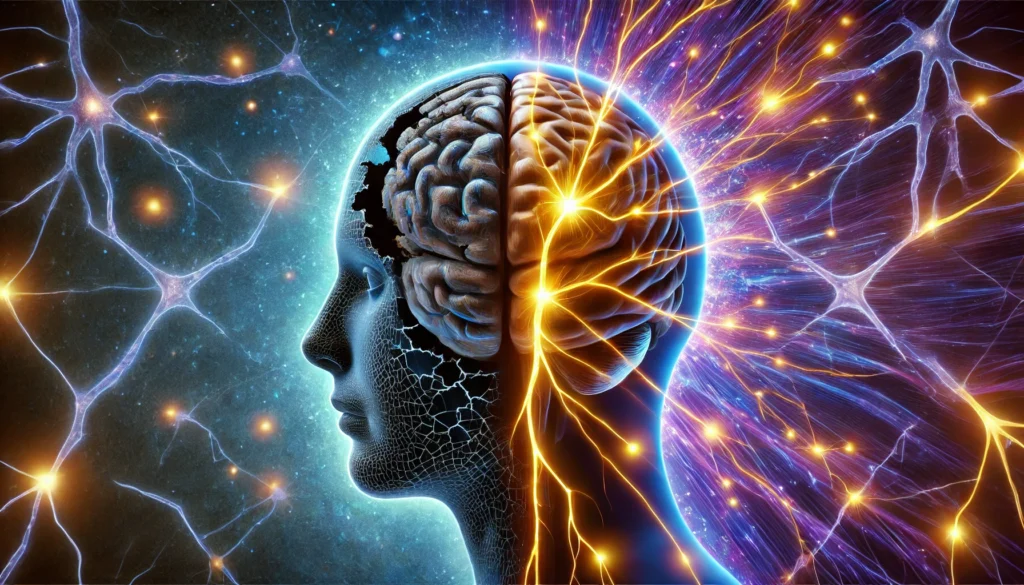Understanding Neural Pathways and Their Role in Memory Enhancement
Neural pathways are the intricate networks within the brain that facilitate communication between neurons, playing a crucial role in cognitive function, memory formation, and recall. These pathways are strengthened through repeated use, much like how muscles grow with exercise. The brain’s plasticity, or its ability to rewire itself, allows for the formation and reinforcement of these connections over time. This adaptability is the foundation of learning new skills, retaining information, and breaking negative habits that may hinder cognitive performance.
You may also like: Habit Formation and Neural Pathway Strengthening: Unlocking the Psychology of Lasting Memory & Recall
When considering how to break bad habits and improve memory, it is essential to understand that neural pathways associated with habitual behaviors are deeply ingrained. Unlearning these behaviors requires conscious effort and the formation of alternative, beneficial neural connections. This is where strategies such as cognitive restructuring, mindfulness, and targeted supplementation can help rewire the brain. By consistently engaging in activities that reinforce positive habits, individuals can strengthen neural pathways that support enhanced memory and cognitive resilience.
The Science Behind Habit Formation and Breaking Negative Patterns
Habits, whether good or bad, are formed through a process known as the habit loop, which consists of three components: the cue, the routine, and the reward. This loop explains why it can be challenging to break a habit, as the brain becomes conditioned to expect a reward following a specific cue. Understanding how to break a habit requires an awareness of these patterns and a willingness to disrupt them intentionally.
One of the most frequently asked questions regarding habit formation is, “How long does it take to break a habit?” While common belief suggests it takes 21 days, research indicates that the timeframe varies depending on the individual, the complexity of the habit, and the level of motivation. On average, studies suggest that it can take anywhere from 18 to 254 days to successfully change a habit. This variability highlights the need for persistence and tailored strategies to support behavioral modification.
Techniques to Stop Bad Habits and Strengthen Cognitive Function
To successfully eliminate negative habits and reinforce cognitive function, adopting a multifaceted approach is essential. One effective strategy involves replacing undesirable behaviors with healthier alternatives. For example, rather than succumbing to distractions while studying, individuals can implement structured study routines that incorporate focus-enhancing techniques like the Pomodoro method.
Another effective method to break unhealthy habits is the practice of mindfulness. Mindfulness techniques, such as meditation and deep-breathing exercises, enhance self-awareness and emotional regulation, making it easier to recognize and resist impulsive behaviors. By fostering a heightened state of awareness, individuals can interrupt automatic habit loops and replace them with intentional, constructive actions.
Physical activity also plays a significant role in reinforcing positive habits and cognitive function. Exercise stimulates the release of neurotrophic factors, which promote neural growth and synaptic plasticity. Engaging in regular aerobic exercise has been linked to improved memory retention, increased focus, and enhanced overall brain health. By incorporating consistent physical movement into daily routines, individuals can bolster their ability to resist negative behaviors and reinforce beneficial cognitive patterns.

The Role of Nutrition and Supplementation in Neural Pathway Strengthening
Dietary choices significantly impact brain function and habit formation. Consuming nutrient-rich foods that support cognitive health can enhance neuroplasticity and facilitate behavioral change. Essential nutrients such as omega-3 fatty acids, antioxidants, and B vitamins are known to support memory function and synaptic connectivity.
In addition to a well-balanced diet, supplementation can aid in neural pathway strengthening. Nootropics, or cognitive-enhancing substances, have gained popularity for their potential to improve memory, focus, and mental clarity. Supplements such as lion’s mane mushroom, bacopa monnieri, and L-theanine have demonstrated neuroprotective properties that support brain plasticity. By incorporating these cognitive enhancers into a daily routine, individuals may experience greater ease in breaking negative habits and fostering long-term memory enhancement.
How Therapy and Behavioral Interventions Facilitate Habit Change
For individuals struggling with deeply ingrained negative habits, therapy for bad habits can provide structured guidance and support. Cognitive-behavioral therapy (CBT) is a widely used approach that helps individuals identify and reframe maladaptive thought patterns contributing to destructive behaviors. Through targeted interventions, CBT empowers individuals to develop healthier coping mechanisms and establish new, positive habits.
Another effective approach involves the use of habit-reversal training. This technique encourages individuals to recognize the triggers associated with their habits and implement competing responses to disrupt the automatic nature of these behaviors. By consistently practicing alternative responses, individuals can weaken the neural pathways linked to negative habits and reinforce more beneficial behavioral patterns.
Practical Steps to Prevent Bad Habits from Resurfacing
Understanding how to stop a bad habit permanently requires the implementation of sustainable strategies that prevent relapse. One of the most effective ways to achieve this is by creating an environment conducive to positive habit formation. Removing triggers that encourage unwanted behaviors and replacing them with cues that promote desirable actions can significantly increase the likelihood of long-term success.
Accountability also plays a crucial role in habit transformation. Engaging with a support system, whether through friends, family, or professional guidance, helps reinforce commitment to change. Additionally, tracking progress through habit-tracking apps or journaling can provide motivation and insight into behavioral patterns, making it easier to maintain progress over time.
Frequently Asked Questions (FAQ) on Strengthening Neural Pathways and Breaking Bad Habits
1. Is stop doing something a bad habit, or is it necessary for habit transformation? Stopping a behavior is not inherently a bad habit; in fact, it is often the first step in breaking unhealthy patterns. The challenge lies in what replaces that behavior. If an individual stops a habit but does not consciously replace it with a positive alternative, the brain may default to another negative habit. To avoid this, focusing on habit substitution—such as replacing excessive social media use with reading or exercise—ensures that the neural pathways associated with the old habit weaken over time. The goal is not just to stop a habit but to actively reinforce beneficial ones that enhance cognitive function and well-being.
2. How long does it take to break a habit, and why does it vary among individuals? The time it takes to break a habit varies due to factors such as habit complexity, individual willpower, and environmental triggers. Some research suggests that forming new habits takes an average of 66 days, but breaking ingrained habits can take longer. The brain’s reward system plays a crucial role in this process; habits tied to strong emotional or physiological responses—such as smoking or binge eating—often require more effort to break. Additionally, social influences and stress levels can accelerate or hinder habit change. Understanding that breaking a habit is a gradual process can help individuals stay committed and avoid frustration when results are not immediate.
3. How many days does it take to break a habit completely? While the 21-day rule is commonly cited, studies indicate that breaking a habit can take anywhere from 18 to 254 days, depending on the behavior. The key is consistency—occasional lapses do not necessarily mean failure, but repeated engagement with an unwanted habit can reinforce it further. Factors such as cognitive load, emotional dependence, and environmental reinforcement all contribute to habit persistence. If a habit is associated with a strong neurological reward system, such as gambling or emotional eating, breaking it might require structured interventions like cognitive-behavioral therapy. Understanding the variability in habit-breaking timelines allows for more personalized and effective habit-change strategies.

4. What are the most effective methods to stop bad habits and create lasting change? Breaking bad habits requires a combination of self-awareness, environmental restructuring, and cognitive reframing. One of the most effective ways to stop a habit is to identify its trigger and modify the routine surrounding it. Mindfulness techniques can help individuals become more conscious of their actions, making it easier to interrupt automatic behaviors. Accountability partners, such as coaches or friends, also enhance commitment by reinforcing positive behavioral changes. Lastly, reinforcing small successes and celebrating progress keeps motivation high, reducing the likelihood of reverting to negative habits.
5. How can I break a bad habit when my environment reinforces it? Environmental factors play a significant role in habit formation and maintenance, making it difficult to stop a habit when external influences encourage it. The key to overcoming this challenge is altering one’s surroundings to minimize exposure to triggers. For example, if an individual struggles with overeating unhealthy snacks, removing junk food from the home and replacing it with healthier alternatives can significantly aid in habit change. Additionally, social support from like-minded individuals who encourage positive behaviors can help counteract environmental reinforcement of bad habits. Finding alternative activities that provide a similar sense of satisfaction can also assist in breaking the habit more effectively.
6. How does therapy for bad habits help in long-term behavior modification? Therapy provides structured guidance in addressing the root causes of negative habits and offers strategies to break them permanently. Cognitive-behavioral therapy (CBT) is one of the most effective approaches, as it helps individuals identify thought patterns that drive unwanted behaviors. By addressing these cognitive distortions, therapy enables individuals to develop healthier coping mechanisms. Habit-reversal training, another therapeutic approach, helps individuals replace destructive behaviors with constructive ones through repetitive conditioning. Engaging in therapy can also enhance self-awareness and emotional regulation, both of which are crucial for long-term habit change.
7. How can I prevent bad habits from returning once I have successfully quit? Relapse prevention is a crucial aspect of breaking unhealthy habits, as old patterns can resurface under stress or emotional distress. One effective strategy is to continuously reinforce new habits through repetition and reward. Engaging in activities that promote cognitive flexibility—such as learning new skills or practicing mindfulness—helps prevent regression. Regularly evaluating personal progress and staying accountable through journaling or habit-tracking apps can also enhance long-term commitment. Additionally, avoiding environments and social circles that previously encouraged the bad habit minimizes the risk of falling back into old behaviors.
8. What role do emotions play in habit formation and breaking habits? Emotions are deeply intertwined with habits, as many behaviors are reinforced through emotional rewards. Habits often develop as coping mechanisms for stress, boredom, or anxiety, making it difficult to remove bad habits without addressing their emotional foundation. For example, emotional eating is driven by the brain’s need for comfort, making simple willpower ineffective for long-term change. Recognizing emotional triggers and developing alternative coping strategies—such as deep breathing, meditation, or engaging in hobbies—can help manage emotional responses without resorting to negative habits. Emotional regulation is a crucial skill in habit modification and should be cultivated alongside behavioral changes.
9. How long does it take to quit a habit related to addiction? Quitting addictive habits often requires more time and effort than breaking simple behavioral routines. While some individuals may experience success within a few months, others require years of sustained effort, particularly if the habit is tied to a strong physiological dependency. Factors such as the severity of the addiction, the presence of withdrawal symptoms, and individual resilience influence the timeline. Seeking professional support, such as counseling or medical intervention, can facilitate the quitting process. Establishing long-term lifestyle changes, including healthier social connections and coping mechanisms, significantly improves the likelihood of permanent habit cessation.
10. What is a simple way to break a bad habit without overwhelming yourself? A simple way to break a bad habit is to focus on incremental change rather than attempting a complete overhaul overnight. Breaking a habit in small, manageable steps allows the brain to adjust gradually, reducing resistance. Habit stacking—linking a new habit to an existing routine—can make the process more seamless. For instance, if someone wants to reduce screen time before bed, pairing that goal with a relaxing bedtime reading routine can reinforce positive change. Self-compassion is also essential, as setbacks are a natural part of habit modification. By maintaining patience and persistence, habit change becomes more achievable without unnecessary stress.

Conclusion: The Path to Lasting Cognitive Enhancement
Strengthening neural pathways and eliminating negative habits is a dynamic and ongoing process that requires dedication and strategic implementation. By understanding the science behind habit formation, adopting mindful behavioral strategies, and supporting brain health through nutrition and supplementation, individuals can cultivate long-term cognitive resilience.
Memory enhancement and habit transformation go hand in hand, as both rely on the brain’s ability to adapt and form new neural connections. Through consistent practice and intentional effort, individuals can break unhealthy habits, reinforce beneficial behaviors, and unlock their full cognitive potential. By embracing these strategies, lasting memory enhancement and overall mental well-being become attainable realities.
Further Reading:
25 Ways to Improve Your Memory
Mechanisms of Memory Enhancement
Important Note: The information contained in this article is for general informational purposes only, and should not be construed as health or medical advice, nor is it intended to diagnose, prevent, treat, or cure any disease or health condition. Before embarking on any diet, fitness regimen, or program of nutritional supplementation, it is advisable to consult your healthcare professional in order to determine its safety and probable efficacy in terms of your individual state of health.
Regarding Nutritional Supplements Or Other Non-Prescription Health Products: If any nutritional supplements or other non-prescription health products are mentioned in the foregoing article, any claims or statements made about them have not been evaluated by the U.S. Food and Drug Administration, and such nutritional supplements or other health products are not intended to diagnose, treat, cure, or prevent any disease.


